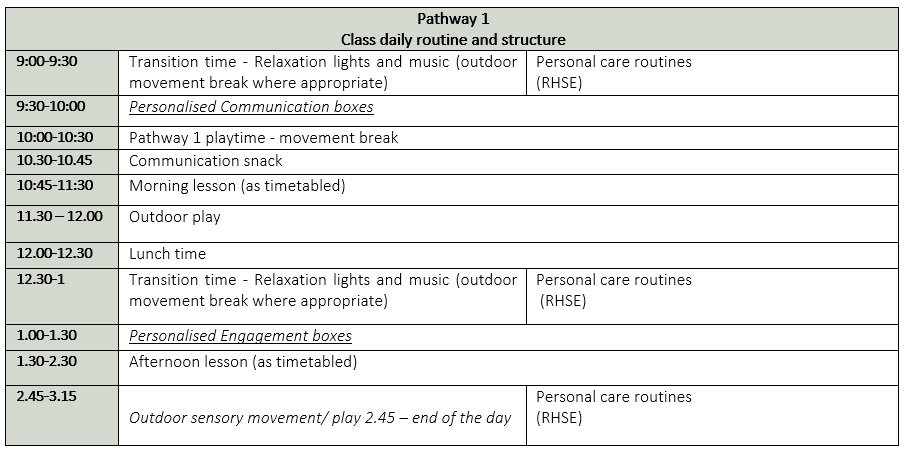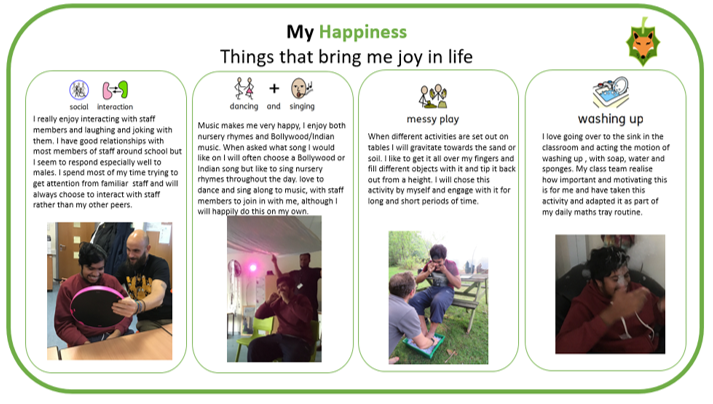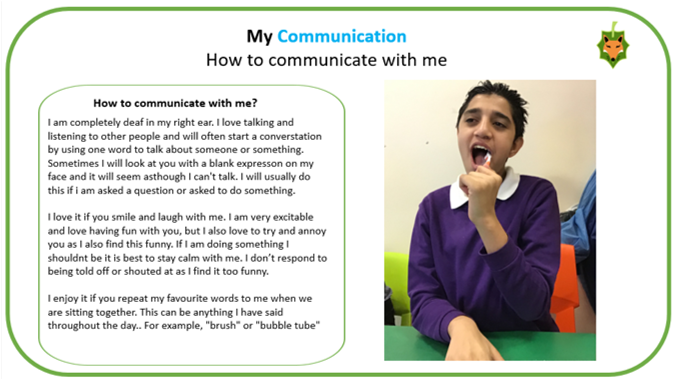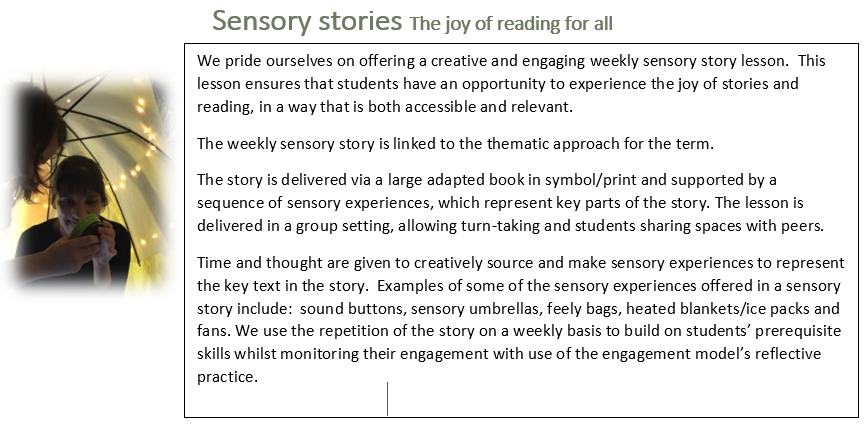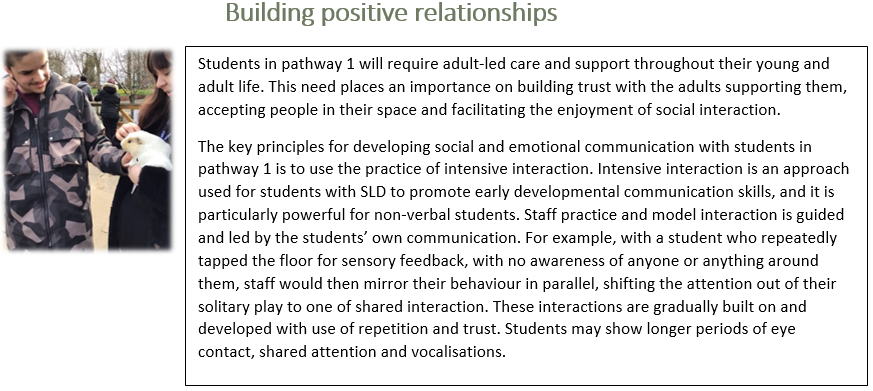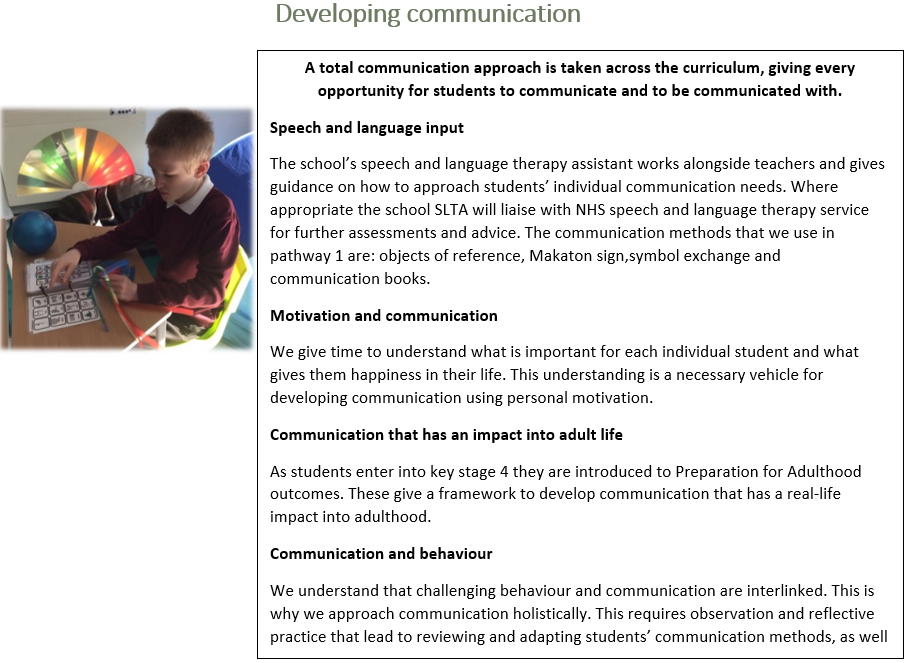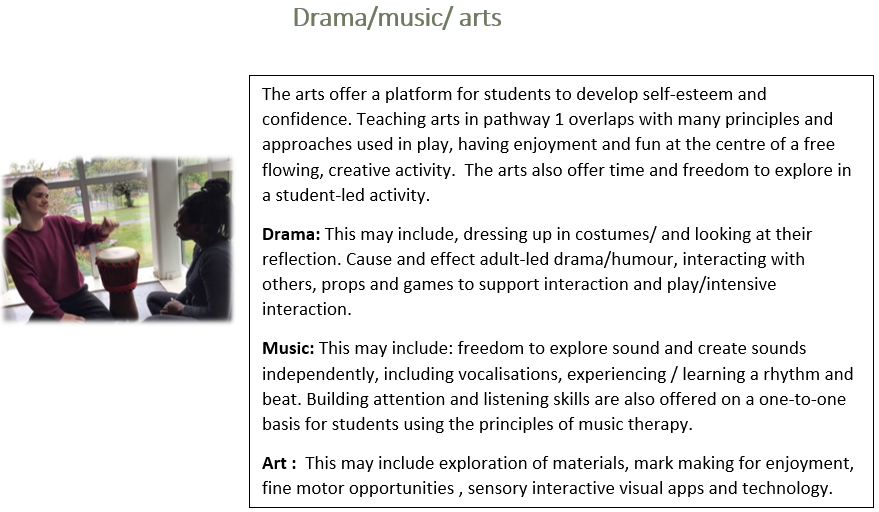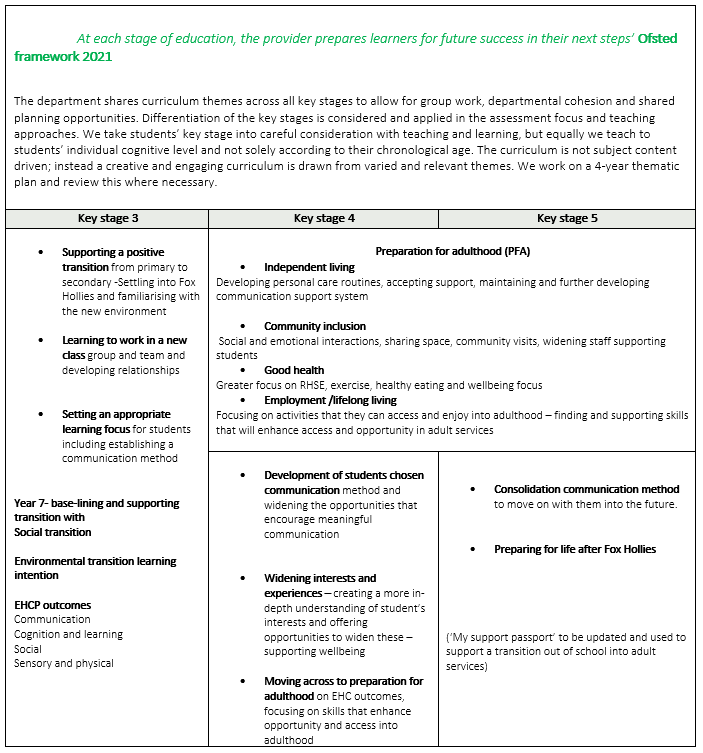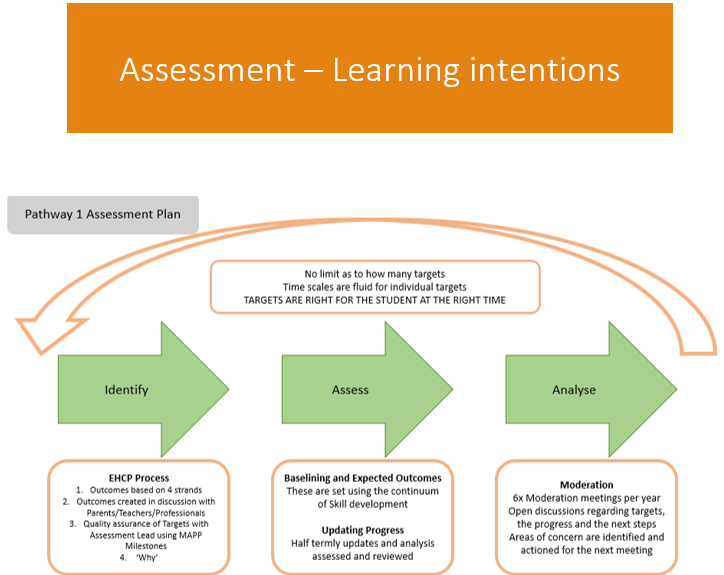Pathway 1 Curriculum
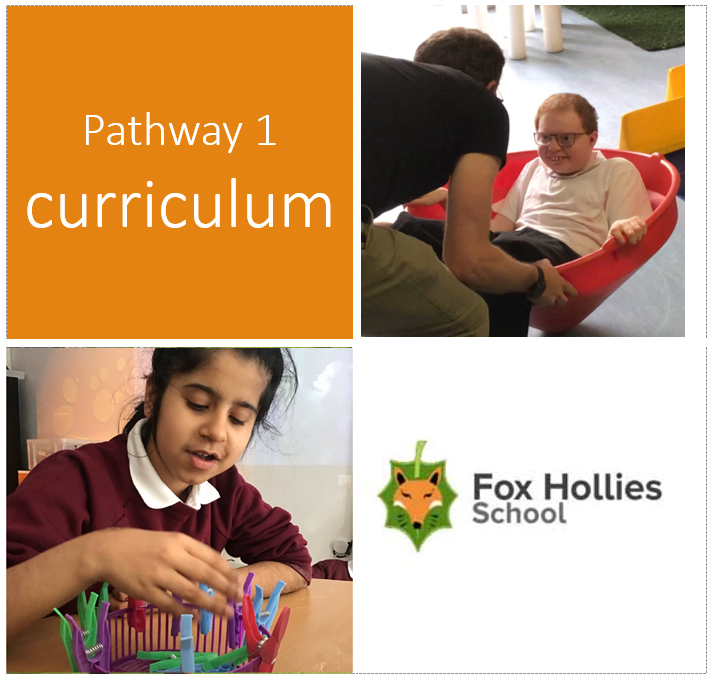
Pathway 1 students have severe learning disabilities, all have a varying range of individual and complex personal profiles. Pathway 1 students are non-subject-specific learners, due to the complexity of their communication challenges, social and emotional and sensory processing needs. The Pathway 1 department consists of five classrooms set along a ground-floor corridor, with doors in each class to an outside space. The five classes are grouped where possible by key stage. Class sizes are around 6 students supported by 4 TAs and a class teacher. Classrooms have a multi-sensory approach to the environment, with movement equipment, lights, and alternative seating options, so that all students can access learning in a way that maximises engagement. The therapy room is also situated on the Pathway 1 corridor.

- Intent, implementation and impact (page 3)
- Thematic approach (page 4)
- Weekly lessons (page 5)
- The school day (page 6)
- Support passports (pages 7 & 8)
- Student-led learning (page 9)
- The engagement model (page 10)
- Communication and mathematical experiences (pages 11 and 12)
- Communication in the curriculum (pages 13,14 and 15)
- RHSE in the curriculum (page 16 )
- Aspirational learning (page 17 )
- Differentiation of key stages (page 18 )
- Assessment (page19 )
- Rationale – evidence-based practice (page 20)
- Intent, implementation and impact (page 3)
- Thematic approach (page 4)
- Weekly lessons (page 5)
- The school day (page 6)
- Support passports (pages 7 & 8)
- Student-led learning (page 9)
- The engagement model (page 10)
- Communication and mathematical experiences (pages 11 and 12)
- Communication in the curriculum (pages 13,14 and 15)
- RHSE in the curriculum (page 16 )
- Aspirational learning (page 17 )
- Differentiation of key stages (page 18 )
- Assessment (page19 )
- Rationale – evidence-based practice (page 20)

Intent curriculum vision, school values and aspirations for studentsWe intend to give students a nurturing and supportive environment, where they can thrive in ways that will have a positive impact on their future life. We aim to offer access to experiences and educational provision for an enriched school experience for all. Our aspirations for students are to feel safe and listened to at school, and have the things that give them joy in life valued, with an overall aim of supporting wellbeing. We work to enable them to communicate their needs and preferences with the staff around them. We intend for students to have experience of a creative and joyful curriculum, one that widens interests and supports social interaction. We also intend for families and carers to feel that their voice is part of the educational process for their child and that school is an open place of support and knowledge. We aim to support students in community participation, and believe that this is valuable for our students and wider society.
|
||||||||||||||||||||||||||||||||||||||||
Implementation: Curriculum approach to teaching and learningOur curriculum is informed by the Equals Informal curriculum document. Our implementation is delivered through the Pathway 1 curriculum and the teaching approaches we adopt. A breadth of opportunities and experiences are offered to students by means of our thematic approach and delivered through our weekly lessons. We place emphasis on giving the time to build therapeutic relationships with students and use the engagement model as a guide to reflective teaching practice to maximise student engagement. We also give regular time to develop a level of independence in personal care routines and life skills. Community participation is promoted with a weekly lesson and a termly community experience day and made accessible for all. Assessment is informed by quality written Education Health Care Plans (EHC). The outcomes are captured using evidence for learning, using the MAPP measuring system to quantify progress. Families have regular opportunities for discussions and support with class teachers and other professionals in school.
|
||||||||||||||||||||||||||||||||||||||||
Impact: The outcomes of educationWe measure ourselves against our aim to give students a positive school experience and create memories and develop skills that they can build on into adulthood. We monitor our own performance and students’ progress through the pathway against whether they have gained increased independence in life skills and personal care routines; whether they have accessed a breadth of educational experiences that have widened their interests and will therefore increase the engagement opportunities accessible in adulthood; whether they have developed a functioning communication method to express needs and preferences; whether they have built positive relationships, enhancing their social and emotional communication; whether families and carers feel listened to, empowered and informed by school on how best to support their young person’s needs. We ensure that Education Health Care plans support a sequential learning focus to guide successful long-term outcomes. Staff observations and therapeutic relationships inform a comprehensive and accurate ‘My support passport’ to aid students’ wellbeing and transition into adult services. Our overall aim is to enhance the quality of life that students will experience and widen their access to opportunities into adulthood.
‘Leaders take on or construct a curriculum that is ambitious and designed to give all learners, particularly the most disadvantaged and those with special educational needs and/or disabilities (SEND) or high needs, the knowledge and cultural capital they need to succeed in life’ Ofsted Framework 2021
‘National Curriculum is not sufficient to meet the needs of pupils and students with profound, complex, severe or global learning difficulties. For these populations, who are all working consistently and over time below or very near the start of their National Curriculum, curricula need to be different rather than differentiated, because the way such pupils learn is different, and often very, very different from neuro-typical, conventional developing learners for whom the National Curriculum was designed.’ (Equals informal curriculum 2021) Enriching the curriculum, not focusing on the assessment Communication and mathematical experience form part of our broad curriculum offer. It should be made clear that students in pathway 1 are classed as non-subject specific learners, therefore we do not discretely teach or assess core subjects. Our students are working at early developmental levels, working below or very near the national curriculum. Our assessment routes are taken from the EHCP outcomes and written and guided by the MAPP Milestones document. Our approach to assessment enables us to create a bespoke assessment path and an adapted curriculum for each student. Creating an individualised curriculum is further enhanced by the use of the engagement model which offers a framework for staff to analyse student’s engagement and adapt the curriculum accordingly. Our focus on engagement is cross-curricular, and includes mathematical experience and communication. Therefore, we facilitate quality moments of engagement in communication and mathematical experience, and do not focus on linear progression. We are teaching communication not literacy Literacy is defined as ‘the ability to read and write’. Students in pathway 1 have significant communication challenges, most having no verbal communication, minimal expressive communication and limited receptive communication. Therefore, to place an emphasis on teaching the ability to read and write would be misdirected, inappropriate and potentially a harmful educational approach. We are clear that our focus for students in pathway 1 remains on supporting their communication challenges at the level they are functioning at. Communication is defined as ‘the process of sharing information, especially when this increases understanding between people or groups.’ An educational focus on communication for pathway 1 students has a far-reaching impact, contributing to student’s well-being, behaviour, outcomes into adulthood, choice-making ability, independence and life skills. Progression in these areas all lead to an increased quality of life. Literacy lead: Specialist support and guidance is offered by the school maths lead by ideas and suggestions for lesson content, supporting with staff with developing schemes of work and supporting pupils through updating and use of relevant resources. Mathematical experiences Mathematics for students with severe learning disabilities is approached differently to their neurotypical peers. For students in pathway 1, early levels of mathematical thinking are experienced in everyday life. A cross-curricular approach is taken to facilitating mathematical experiences, and is not taught as a discrete lesson or subject. Instead, we facilitate quality mathematical experiences throughout the curriculum, ensuring practical and engaging breadth of experiences. Mathematics for students with severe learning disabilities should be practical and social and embedded in their daily activities and routines, in which they will develop: ’physical skills, sequential skills and memory, anticipating or predicting changes, making choices, communicating about and affecting changes Les Staves Very Special Maths Mathematical concepts incorporated into termly themes We offer mathematical development opportunities through teaching key mathematical concepts through the termly themes. Our areas of coverage within Maths are: Position and Direction, Size and Volume, and Sequencing and Sorting. We aim to facilitate engaging, functional, relevant and personalised mathematical opportunities throughout the curriculum. This involves focused learning opportunities throughout the subject areas of Music, Art, Movement, Gardening and Sensory Food. Elements of Number and Counting are incorporated throughout our curriculum. Mathematical experiences occur throughout the curriculum including:
Maths lead: Specialist support and guidance is offered by the school maths lead by ideas and suggestions for lesson content, supporting with staff with developing schemes of work and supporting pupils through updating and use of relevant resources.
What is relevant and important to teach? 35. In special schools and for some SEND pupils in mainstream schools there may be a need to tailor content and teaching to meet the specific needs of pupils at different developmental stages. As with all teaching for these subjects, schools should ensure that their teaching is sensitive, age-appropriate, developmentally appropriate and delivered with reference to the law. (Relationships and Sex Education (RSE) and Health Education, Statutory guidance, 2020) In Pathway 1 RHSE is approached in a personalised and relevant way for students with complex needs. Within the pathway we focus on 3 areas which weave through the curriculum at all times · Relationships and social interaction -Building relationships and encouraging interaction is supported through such approaches as intensive interaction and play/drama. This helps to support the students’ social and emotional challenges. There is a particular need to focus on expression of yes/no – this is consent. · Personal Care Needs -Most of our pathway 1 students require support with their personal care needs. Each student has their own protocol which is guided by the school’s intimate care policy. Consent is at the core of this basic need · Puberty - Puberty is a developmental process all our students go through. It is something we aim to support in an individualised manner through informed discussion and guidance from our families Sex Education- Creating an open dialogue with families and carers 42. Parents should be given every opportunity to understand the purpose and content of Relationships Education and RSE. Good communication and opportunities for parents to understand and ask questions about the school’s approach help increase confidence in the curriculum. (Relationships and Sex Education (RSE) and Health Education, Statutory guidance, 2020) We aim to support students to manage the changes to their body that they will experience and the challenges this may cause for them. For pathway 1 learners Sex Education is not suitable to be taught in a discreet lesson due to the cognitive level of students, instead a highly personalised approach is taken to support their needs.We work in collaboration with parents to tailor each individual students support by discussing behaviours related to sexual expression with family’s and careers during EHCP meetings and communicate any other …. An approach to support students sexual expressive need is decided and planned in students individual documents ; support passports, behaviour plan and risk assessments. Some students may required enhanced support to manage their expressive sexual behaviour and other students may display little to no expressive behaviours.Therfore, we tailor our support on the need of the students at the time they are experience it as this allows learning to be real and relevant. How is RHSE taught in the curriculum?
The school day is structured in a consistent, segmented routine, allowing for students to cue into what is happening around them at specific times, and to understand what is expected of them. This predictability helps to ease anxiety for students, which is particularly beneficial for those with an additional diagnosis of autism. Structure and routine are important for transitions, which can often cause distress. We communicate the transition and prepare students to anticipate change with a daily routine. For example, during the morning transition into school, the classroom will have relaxing sensory lights and music on. The lights and music will then be turned off at 9.30am, ready for students to start their individual communication box. Students can begin to read their environment and anticipate what is happening next. The daily routine offers a structure. However, all students are given flexibility and regular opportunity to communicate a need to change routine if required.
‘The curriculum and the provider’s wider work support learners to develop their character – including their resilience, confidence and independence – and help them know how to keep physically and mentally healthy’ Ofsted inspection framework 2021
‘My Support Passport’ is an accessible and personalised document written for each student in pathway 1. The purpose of the support passport is to be an informed and collaborative live document, with all relevant information regarding a student, collated with photographs into an accessible format. ‘My support passports’ are built on a similar principle to one-page profiles that are frequently used in SEN schools. However, the support passports aim to be a more comprehensive guide to each student’s needs. Creating this comprehensive guide is particularly important for students in pathway 1, who have a limited/no spoken language, and whose needs are heavily reliant on staff observations. The passports are written in the first person, creating a platform for the student’s ‘voice’ to support a personalised curriculum. The Support passport is divided into five areas: Happiness Wellbeing Communication Daily support needs Safety
Students in pathway 1 have limited expressive language and will require a high level of support throughout their young and adult life. The passport aims to create a platform for their ‘voice’: What is important to them in their life? How to promote their wellbeing? How to keep them safe? This information is challenging to access, therefore a collaborative approach is taken to collate this information by using observation, given from families, a range of staff supporting the pupil, speech and language, as well as taking any relevant information from current assessments/reports. This allows the passport to best reflect the student’s ‘voice’ from a number of observations from a range of people. The importance of creating a platform for each student’s voice is particularly relevant when working with Preparation for Adulthood and supporting students to transition out of education and into adult services. The information in the passport can offer a comprehensive insight into students that staff in collaboration with families/other professionals have spent a significant time building. This information can have a real-life impact for students when accessing new carers who support families at home or in respite, and also new staff working with students/day centres.
‘Relationships among learners and staff reflect a positive and respectful culture. ‘ Ofsted framework 2021 To give voice and autonomy to students, we must first understand and respect their identity, including their neurological differences. To create a personalised curriculum around students we must listen to their ‘voice’ and what is important to them, valuing their autonomy in their life and not trying to mould or correct their identity into a ‘norm’ associated with typical development. Student-led learning is facilitated with staff observations and reflective practice to adapt the curriculum to each individual’s needs. This reflective teaching process supports increased student engagement and motivation that is both personalised and meaningful for the individual. We fit the curriculum around the student, not the student into the curriculum. The Equals informal curriculum offers some key points to ensure student-led learning is facilitated successfully, so that each student will:
‘Effective use of the engagement model is based on regular observational assessment and reflective pedagogy. Observational assessment is central to understanding what the pupil knows and what they can do. ‘The engagement model DFE 2020 What is the engagement model? The engagement model is an educational framework that was introduced in 2020/21 by the DFE to replace P-levels 1-4. It affects students working below the national curriculum and those who are not engaged in subject-specific study. The framework is not statutory assessment in a secondary setting, and therefore schools have the ability to utilise the principles and practices for their setting. The engagement model offers a framework for schools to move away from linear assessment routes for this student group, instead putting a greater emphasis on lateral progress. The model looks at capturing the quality of student engagement on an individual basis.
The framework breaks engagement five key areas: Exploration. Realisation. Anticipation. Persistence. initiation. Reflective teaching practice The engagement model principles focus on reflective teaching practice, taking time to observe students and the quality of their engagement. This reflective practice serves to inform future steps and changes to teaching and learning, to increase learning/ engagement. Teachers and support staff give time to review students’ learning in an in-depth way, reviewing and adapting the teaching and curriculum approaches to maximise engagement for each student. The Engagement Model is not an assessment route or curriculum document. It is an overarching educational principle to approach education for students in pathway 1. We use the principles of the engagement model in all aspects of our curriculum by embedding observational reflective practice, quality engagement and a focus on lateral progression. This helps to form a curriculum where learning has meaning and relevance for individual students.
‘The curriculum extends beyond the academic, technical or vocational. It provides for learners’ broader development, enabling them to develop and discover their interests and talents’ Ofsted inspection framework 2021 Sensory stories The joy of reading for all
|
||||||||||||||||||||||||||||||||||||||||









